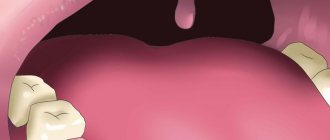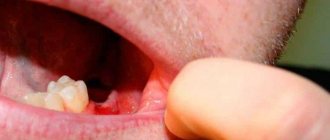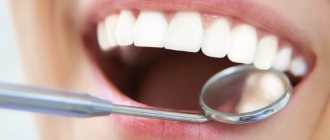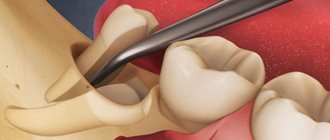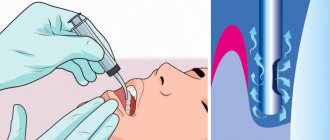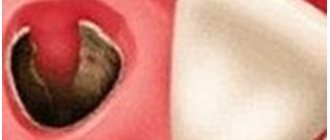Symptoms Causes Consequences Alveolitis Diagnosis and treatment Features of wisdom teeth Treatment at home Prevention
Tooth extraction is one of the most popular and simplest operations in medicine. Usually it passes without complications, but due to a number of general or subjective reasons, deviations may occur. One such postoperative complication is dry socket.
The fact is that after extraction of a tooth, a cavity forms in its place, which, in a positive scenario, is filled with a blood clot. It prevents the penetration of microbes into an open wound and promotes its speedy healing. A dry socket after tooth extraction is the absence of that same blood clot in the socket. This can happen for two reasons:
- Loss or resorption.
- Severe bleeding that prevented a clot from forming.
Whatever the reason, the healing process can take weeks and be accompanied by serious discomfort, which is not always possible to eliminate on your own.
Symptoms
Dry socket syndrome is very painful. It is quite easy to identify if the following symptoms appear within 2-3 days after tooth extraction:
- inflammation of the gums, accompanied by severe pain;
- pain in the cervical region and ears;
- the appearance of bad breath;
- taste of pus in the mouth;
- partial hearing loss;
- general malaise
Visually, a dry socket is an empty depression at the site of tooth growth, first exposing the jawbone, and then turning into a reddened, purulent wound.
Normally, the socket is a cavity that, after tooth extraction, is filled with ichor. Over the next three days, the clot thickens, and light fibrin stripes appear on it - the beginning of the formation of new gum tissue. There may be slight soreness at the wound site. From 4 to 7 days, swelling gradually subsides, and the gums acquire their usual pink color. There is no pain.
Causes of dry socket
There are several causes of dry socket. Some of them can be prevented by following simple recommendations regarding personal hygiene and caution. Causes:
- smoking. In this case, there is a decrease in pressure in the oral cavity, which can lead to the loss of the formed clot;
- neglect of oral hygiene;
- low blood clotting;
- taking oral contraceptives;
- mechanical damage to the hole itself or the tissues around it.
In addition to the above reasons, a dry socket can appear as a result of an incorrectly performed tooth extraction procedure. During a complex extraction, when the tooth had to be removed from the gums in parts. All rules recommended before and after extraction must be followed.
Consequences
If during the first two days after tooth extraction pain appears, swelling does not subside and the temperature rises, then most likely these are signs of inflammation. In this case, you should immediately consult a doctor, as dry socket syndrome can lead to serious complications. Such as:
- flux.
It begins to form when an infection gets into the hole. Characterized by severe swelling and pain. Requires immediate specialist intervention. - alveolitis
This is a deeper penetration of the infection - deep into the gums. Bacteria spread quickly and, if this process is not stopped in time, there is a risk of tissue necrosis. In this case, the losses can be very serious.
Attention!
The consequences of untimely or incorrect treatment can be irreversible. Do not neglect your doctor's advice. A wound on the mucous membrane is always a vulnerable area, subject to attack by bacteria and their rapid spread.
Causes of swelling after removal
Swelling of the mucous membrane in the area of removal in the gum area, as well as swelling of the cheeks, are also considered normal after wisdom tooth extraction. This is explained by tissue injury and the body’s natural reaction to the procedure. Normally, swelling increases the next day after visiting a dental surgeon, but then, if all recommendations are followed, it should subside.
If the swelling continues to increase, you should consult a doctor. The same applies to situations where, in addition to tissue swelling, there is increased pain, discharge from the socket, and increased body temperature. The listed signs indicate inflammation, which requires initiation of treatment.
The signs will be especially pronounced if there was already purulent inflammation at the time of visiting the dentist. In this case, even a correctly performed procedure, creating an outflow of inflammatory exudate, does not exclude an increase in tissue edema. When removing the upper tooth, swelling may spread to the orbital area. During surgery on the third molar of the mandible, swelling may extend to the neck and ear area. If after a day the symptom becomes less pronounced, we can assume that there are no complications.
In addition to increased swelling and pain, the following signs will be an indication for an emergency visit to the dentist:
- Discharge of pus from the socket.
- Bleeding.
- Pain when swallowing.
- Pain when trying to open your mouth.
- Swelling of the face, accompanied by redness of the skin.
It is unlikely that tissue swelling will be completely avoided, but the risk of complications can be reduced. It is enough to follow the doctor’s instructions, take prescribed medications and monitor oral hygiene.
Forms of alveolitis
Depending on the course of the complication, three stages are distinguished:
- Serous.
It makes itself felt
2-3 days
after tooth extraction. At this stage, pain occurs when eating, headache. Lymph nodes increase in size. - Purulent.
This is the next form that occurs after the serous one, if timely treatment is not carried out. Diagnosed a week after the tooth was removed. The pain becomes unbearable and is also felt in the head or ear. The hole becomes covered with a purulent, dirty yellow coating. There is an unpleasant odor from the mouth. Swelling and lymph nodes enlarge and become painful. Opening your mouth and eating food is extremely difficult due to pain. - Hypertrophic.
At this stage, it seems that the symptoms are subside: the condition is normalized, the temperature decreases. However, atrophied tissue grows, and when pressure is applied, pus is released from the inflamed wound.
If you notice any of the above symptoms, you should not self-medicate, but rather consult a dentist.
How to relieve pain after tooth extraction?
When the effect of the anesthetic begins to wear off, the pain will return. In case of severe pain or a low pain threshold in the patient, it is necessary to take painkillers.
As a rule, non-steroidal anti-inflammatory drugs (diclofenac, voltaren, indamethacin, nimesulide, ibuprofen) are taken, which will also help relieve swelling and inflammation. It is worth remembering that long-term use of these drugs is contraindicated due to a decrease in the number of leukocytes in the blood and complications from the stomach. Most drugs in this group should be taken with omeprazole.
In addition, you can resort to using a topical drug in solution or lozenges: benzydamine hydrochloride (or tantum verde).
Diagnosis and treatment methods
Diagnostics at a dentist's appointment will help confirm the symptoms of a dry socket. After an examination, the doctor will prescribe treatment. As a rule, it depends on the stage of inflammation. In the case of a mild form, drug treatment with antiseptics and anti-inflammatory drugs is possible. At the middle stage, you will need antibacterial therapy, as well as cleaning the hole from pus and filling it with an anti-inflammatory drug. All actions are performed under anesthesia. If necessary, antibiotics are prescribed.
At the third stage, the most advanced stage, the patient may need hospitalization and even surgical intervention. With proper care and no complications, the hole heals within seven days. And a month later there is no trace left of her.
What do doctors recommend?
For several days, it is necessary to rinse the oral cavity with an antiseptic solution, which will prevent the entry of microbes from the external environment through the wound surfaces of the gums. The number and duration of rinses is determined by the attending physician. Rinse solutions should be no cooler than room temperature and no hotter than 37 degrees. The simplest and most inexpensive option is a solution of baking soda (1 teaspoon per glass of water). In addition, rinsing can be done using pharmaceutical products.
Rinses from the pharmacy
| Iodine-containing products | Iodinol, yox (spray) |
| Chlorine-containing | Chlorhexidine, miramistin, eludril, |
| Nitrofuran | Furacillin |
| Based on hexetidine | Stomatidin, hexoral |
| Vegetable | Chlorophyllipt, calendula tincture, |
| Antiseptic lozenges | Faringosept, septolete, grammidin |
| Means to accelerate the healing of mucous membranes | Rotocan, dental paste solcoseryl, stomatophyte, propolis spray, sea buckthorn oil. |
| Infection Control Products | Antibiotics, bacteriophages (staphylococcal bacteriophage, pyobacteriophage) |
Features of wisdom tooth removal
Dry socket after wisdom tooth removal is not uncommon. This syndrome occurs especially often in the lower jaw due to the fact that as a result of swallowing and opening the mouth, the muscles tense, aggravating the appearance of a dry socket and, as a result, alveolitis. Dry socket occurs in approximately 50% of cases
. Due to the anatomical features of the jaw, the blood clot often falls out.
When extracting a wisdom tooth, you must carefully observe precautions and resort to this procedure only in cases of extreme necessity. After all, the inaccessibility of the place complicates treatment.
Painkillers –
If the extraction was simple, you may not need pain relief after tooth extraction. But if you want to completely prevent the appearance of pain, then it is better to take a strong tablet analgesic even before the anesthesia wears off (which one is better to choose - see the link, but remember that after removal you cannot take aspirin).
Sometimes the pain is very severe. As a rule, this happens if the removal was performed by a doctor in a very traumatic way or if inactive bone fragments were left behind. The pain is most severe when the doctor used a drill to drill out the bone, and water cooling was not used (this leads to necrosis of bone tissue as a result of overheating).
Important: numerous studies show that the severity of pain after tooth extraction is reduced by an average of 30-50% if the doctor places sutures on the socket of the extracted tooth. In addition, bringing the edges of the mucous membrane together by applying sutures helps protect the blood clot from loss and injury, sharply reduces the risk of developing inflammation of the socket, and almost completely eliminates the occurrence of bleeding.
After a simple simple extraction, most dental surgeons very rarely use sutures. I can recommend for the future - always before removal, ask your surgeon to put 1-2 stitches on you, even if the removal is simple, and even if you have to pay an extra 300-400 rubles for it. As a rule, sutures do not have to be removed (they dissolve on their own), but they will reduce pain and reduce the risk of complications.
Treatment of dry tooth socket at home
If the pain from dry socket inflammation is too severe, you can take painkillers. In the first two days, apply cold compresses to the inflamed side at intervals of 20 minutes, then change to warm ones.
Drink more fluids, especially water. It removes harmful substances from the body. Avoid alcohol.
Rinse your mouth with a salt water solution. This clears the wound of dead cells and relieves inflammation. But you should not apply pressure in the area of the hole - you can provoke the displacement of the blood clot. You should rinse your mouth after every meal and before going to bed.
You can also apply a drop of clove oil to the wound to relieve pain. Rinsing with sage and chamomile flowers, a decoction of burdock leaves and aspen bark, and anise infusion will also have a positive effect.
If after all the treatments the pain has not subsided, the swelling has not subsided, and your health has only worsened, then you should urgently consult a doctor. There is a high probability that the process of rotting has begun.
In the dental office, the doctor, under anesthesia, will clean the hole or prepare the gums - depending on the degree of neglect of the case. Fill it with antiseptic gel.
How long does it take for the mucous membrane to heal after removal?
The duration of the healing process depends on a large number of factors. First of all, the difficulty of removal matters. The removal technique also has an effect, that is, extirpation of the roots in parts, cutting of the tooth. It is important to take into account the initial condition when visiting the dentist. The hole will take longer to heal if the tooth is located outside the dental arch, grew in the jaw at an angle, or was located horizontally in the dentition. The presence of an inflammatory process near the tooth, especially signs of purulent inflammation and pericoronitis, also increases the healing period.
When sutures are applied after a simple removal, within a week the patient will forget about the procedure, but it is too early to think about prosthetics or implantation. With complex removal, the healing process will take slightly longer. If complications arise after surgical treatment, wound sanitation, treatment, and suturing are required, then the time for complete healing may increase to 20 days. Complete restoration of the mucosa takes at least three weeks. Only after this can implantation and prosthetics be performed in the area of the removed wisdom tooth.
Normally, gums must go through several stages:
When going to the dentist, it is recommended to immediately plan your day. This is especially true if there are already signs of inflammation or the teeth are severely damaged, that is, a difficult extraction is expected. Recommendations after wisdom tooth removal include, first of all, complete rest on the day after surgery. You should not make sudden movements, bend over, visit baths and saunas, or take a hot bath. It is prohibited to play sports or do any work while bending over. The best option would be complete rest. There is no need to do any special procedures on the day of the operation.
Smokers are advised to abstain from cigarettes if possible for three days or more if there are signs of complications. Nicotine causes vasoconstriction and disrupts tissue nutrition, which slows down regeneration processes. In addition, the risk of wound infection increases.
After a couple of days, you should visit the dentist who performed the procedure to assess the condition of the tissue and the healing process. This must be done even if the patient is not bothered. If signs of complications appear, pain and swelling increase, and bleeding does not stop, consult a doctor without waiting for the appointed date.
If sutures were placed on the wound, they are removed after 8-10 days, or a follow-up examination is scheduled if self-absorbable material was used for the sutures.
Do not touch the wound or try to remove part of the clot or remnants of the medicine in the form of sponges. This will only worsen the situation and cause complications.
What do we have to do?
On the first day, do not rinse your mouth. From the second day, procedures can be carried out. In this case, you do not need to intensively rinse the contents of the hole; just hold the solution on the sore side for a few seconds and spit. You need to repeat the procedure several times a day, especially after meals.
Chlorhexidine, furatsilin, miramistin, and potassium permanganate can be used as a rinsing solution. It is also possible to use herbal decoctions, for example, sage, chamomile, calendula or dental collection.
Pain may occur after the anesthetic wears off. To eliminate them, the dentist must prescribe analgesics. If there is no prescription, you can take any painkiller that the patient is used to using for pain. If the pain increases and the tablets do not help, you cannot increase the dosage. An increase in symptoms indicates a complication that requires medical intervention.
If you don't want to take medication, you can use a cold compress. These can be ice cubes wrapped in a towel. They need to be applied for several minutes, avoiding hypothermia of nearby organs, in particular the ear and tonsils.
If there is a high risk of inflammation, as well as if there is purulent discharge at the time of surgery, the dentist will definitely prescribe antibiotics. The doctor calculates the name of the drug and duration of use individually.
Features of nutrition after surgery
After wisdom tooth removal, it is forbidden to eat for two hours. If after the specified time the effect of the anesthetic still persists, it is better to wait until sensitivity appears. Eating food with a numb tongue and cheeks can cause injury to the mucous membrane.
On the first day after surgery, you can only eat warm food and drinks. Products should be soft, for example, cereals, chopped soups, yoghurts. Next, you should follow simple recommendations for several days:
- Avoid hot or too cold food.
- Avoid eating hard foods such as crackers and nuts.
- Chew food only on the healthy side so as not to put stress on the wound.
- After eating, be sure to rinse your mouth.
- You can include more fruits and vegetables in your diet to boost immune strength, or supplement with complex vitamins from the pharmacy.
You cannot drink alcoholic beverages. It is also recommended to reduce sweet foods in the first days, as they create a favorable environment for the development of bacteria.
Features of oral hygiene after removal
On the first day after extirpation, you should abandon the usual brushing of your teeth, limiting yourself to a light rinse before going to bed to remove any remaining food. The next day, you are allowed to use a toothbrush and toothpaste, but the surgical site is treated with special care. When brushing your teeth, do not forget that you cannot actively rinse your mouth. After three days, the wound will have healed and you can return to your usual hygiene regimen and brush your teeth twice a day.
Prevention
Preventing dry socket is always easier and cheaper than treating dry socket. To do this, you need to follow a number of preventive measures. Namely:
- If possible, limit physical activity for several days after tooth extraction;
- do not touch the removal site with your hands or tongue;
- do not chew on this side;
- eliminate the use of tobacco and alcohol;
- do not eat too hot, cold or spicy foods;
- It is advisable to grind food into puree.
Expert of the article Bolshakova Evgenia Vladimirovna Dentist-hygienist
More than 11 years of experience
Treatment in the clinic
The optimal solution for treating a diagnosis of dry socket or alveolitis is a visit to the dentist. It is better to go to the same doctor who performed the tooth extraction, since he already knows the course of the operation, did the diagnostics and remembers the characteristics of your body.
Whatever clinic you choose to contact, study its website, the doctors who work there and reviews.
At the RUTT dental center we use the latest equipment and advanced materials. The experience of our doctors is confirmed by numerous diplomas, certificates and awards. You can be sure that you will be in the hands of a reliable specialist.

